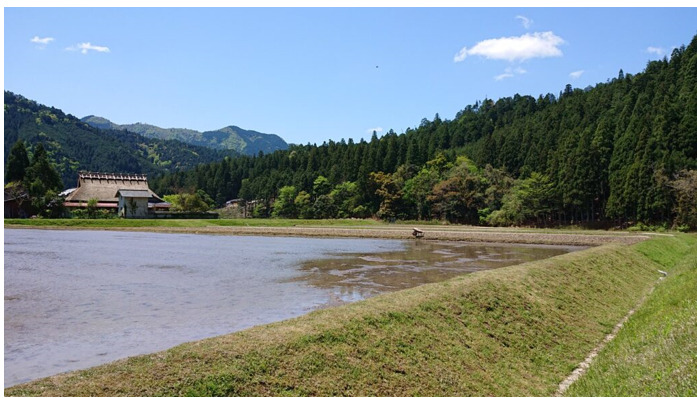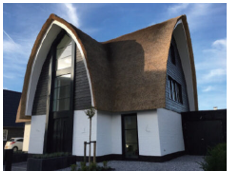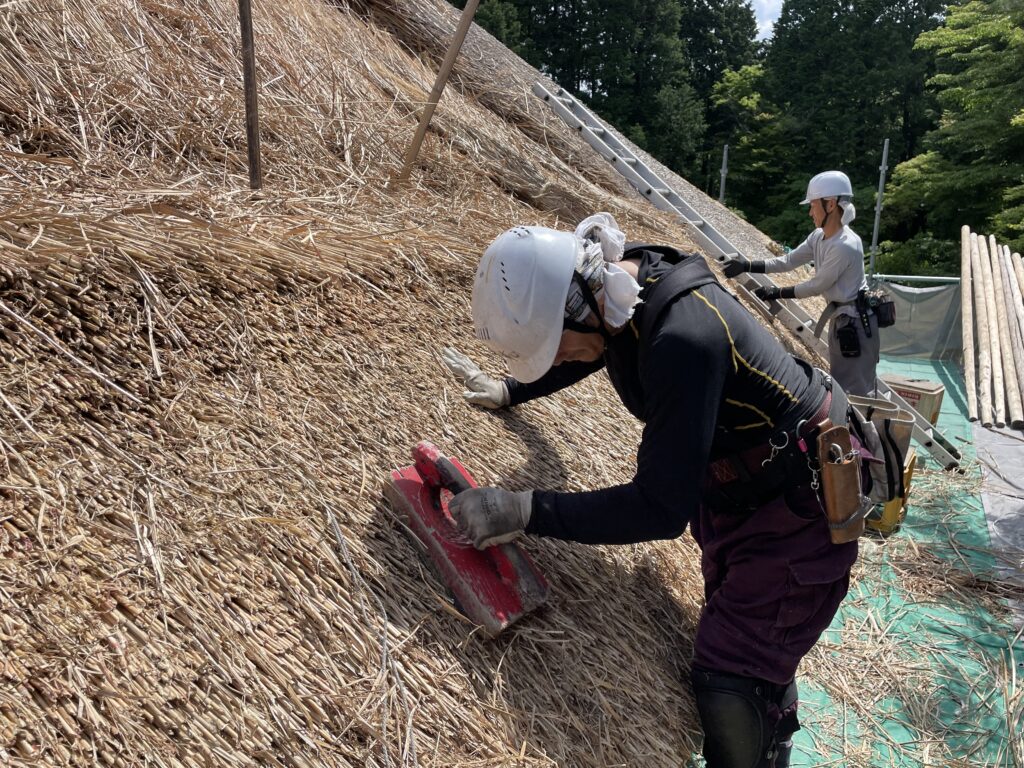The essence and possibility of thatching
The essence of traditional thatched roofs is not as a traditional house itself but as a synthesis of the wisdom of our ancestors who have lived in harmony with nature for thousands of years, and is a synthesis of life, the universe, the earth, nature, people, architecture, cities, culture, history, the future, and the activities of all things in circulation.
It is the environment itself that supports the traditional and unique lifestyle and culture that has been updated in each era of the land. It includes the mountains, the forests, the rivers, the oceans, the sky, the fields, the rice paddies, the fields, the people’s livelihoods, the local economy, and everything in between. It is also connected to the universe. And together with the great cycle of nature from the forest to the sea, it has fostered a beautiful landscape.
Climate change, environmental problems, infectious diseases, local issues, the cacophony of the nation and the world, there are so many problems in this days, but by scientifically reevaluating thatched roofing and the traditional wisdom associated with it, applying it to the modern age, and developing and designing models that can be applied in the future, we can solve these problems and create a sustainable society.
Regreen, we will do this in the fields of architecture, urban design, landscape architecture, land planning, and environmental design with research and development.


The summarize of the benefits and features of thatch and thatching in Japan.
Thatch is friendly to people and nature, and is the best cyclical material that can be used for roofing and interior materials. Thatch has many functions for the mother environment and local environment, such as carbon dioxide absorption, carbon fixation, purification of soil, improvement of water and air quality, prevention of landslides, and so on. It has used also as insulation of buildings and snow fence in the winter season. After using as roofing material, old thatch is taken down and used as fertilizer for rice and vegetable field. It can make delicious, safe, and secure food for people. Also, old thatch will be as beetle nest. Growing rice produces rice straw, which can be used for many purposes, including as material for earthen walls, straw crafts, shimenawa (sacred straw rope), and so on.
You can find out the benefits and features of thatch and thatching below.
As architecture, landscape and culture
・Possible to use not only for roofing materials, but also for interior and exterior materials, insulation, furniture, and products.
・As the primordial home of mankind, traditional thatched roofs are found all over the world, creating their own original landscapes and healing landscapes.
・As modern architecture (new thatched buildings and houses are being built in the Netherlands and other parts of Europe).
・The essential human way of life in which a fire can be built inside the house (sunken hearth, kamado).
・The thatched houses are cool in summer and warm in winter (thatch has almost the same level of thermal insulation as that used in modern houses. The cold in winter is due to drafts from the walls and floors, and if the walls and floors are well insulated, the building will be comfortable in winter too).
・Fermented food can be made inside the thatched house.
・A space that protects the inside from strong sunlight, sound, rain and wind, electromagnetic waves, sunlight, and many other things, and gives a sense of security like being in the mother‘s womb (dimly lit, quiet even in the rain, warmth, natural smells…).
・A structure that can be lived in for hundreds of years, and is soft and resistant to the forces of earthquakes and typhoons. Can be dismantled, relocated, converted, extended and reduced freely.
・Flexible response to environmental changes
・Architecture that constructed with local resources and ultimately returns to the soil.
・Not only used in private houses, but also in shrines, temples, cottages, hotels, tea ceremony houses,
and in Japan’s most important ceremonies, such as the Daijougu at the Daijousai and the Ise Jingu Shrine.
・Rice cultivation, sericulture and thatching were fundamental to Japan‘s nation-building system. The beautiful name of Japan, “Toyoashihara-no-Mizuho-no-kuni”, also has a word for reeds (thatch), and Emperor Jinmu’s father was “Ugayafukiaezu no Mikoto” and his great-grandmother was “Kaya-no-Hime”, who were associated with thatch. There is a deep connection between thatch, thatching and Shinto, ancestors of Emperors, and history of Japan.
Things that lead to human health
・Many people live to a ripe old age without serious illness and live a long natural life (testimony of dozens of people who live on thatched roofs).
・People can sleep deeply (Results of an overnight stay demonstration test with more than 50 pairs of men and women of all ages on thatched roofs in Miyama, Kyoto, Japan).
・Symbiosis with a diverse range of naturally occurring micro-organisms, preventing the growth of pathogenic micro-organisms and reducing susceptibility to disease. Possibly effective against coronaviruses.
(Daisuke Ogura, Fumito Maruyama et al(2021), “Relationship between the Microbiome and Indoor Temperature/Humidity in a Traditional Japanese House with a Thatched Roof in Kyoto, Japan”, Diversity 2021)
・Among the bacteria detected in thatch, about 1/4 of all bacteria are those that increase immunity (results of a Kyoto University study).
・Hypersonic sound effect(Hypersonic sound, above 20,000 Hz, has the effect of raising people’s immunity, reducing stress and activating their natural sensitivity.)
( TSUTOMU OOHASHI, EMI NISHINA, MANABU HONDA, et al (2000), “Inaudible High-Frequency Sounds Affect Brain Activity : Hypersonic Effect”, Journal of Neurophysiology Volume 83 Jun 2000)
Regreen found out that thatch harvesting, roofing works, making thatch products, traditional works, and traditional instruments also emit hypersonic sound. BBC made the program based on this investigation and possibility with talks from the expert researcher about hypersonic sound effect in March 2023.
・Air purification by the smoke from sunken hearths.
・The sterilizing, disinfecting, and longevity-enhancing effects of the wood vinegar solution from the sunken hearths.
Contribution to circulation, environment and ecosystems
・Contributing to carbon fixation, can eventually be used as fertilizer, and is the best cyclical material that can be returned to nature.
・Possible to use thatch as an environmental regenerator. Thatch roots improve soil condition, purify groundwater and air.
・A forest-like roof that nurtures all kinds of livings such as insects, birds, moss, trees, and plants.
・Thatch is classified as a C4 plant, which absorbs more carbon dioxide and emits more oxygen by activating photosynthesis even in hot and dry environments (General plants, most of trees, grasses, and flowers are classified as a C3 plants whose respiration is more dominant than photosynthesis in hot and dry environments. It is important to make balance what kind of plants to plant for climate change).
・Water source recharge (the water source recharge capacity of grasslands is higher than that of cedar forests).
・Soil carbon stocks in grasslands are higher than in cedar forests. Soil carbon fixation is significantly higher even after field burning (according to the results of a study by Tsukuba University).
・The forests and thatch areas with biodiversity promote the natural cycle from the forest to the sea, prevent landslides, and prevent damage in rice and vegetable fields by animals.
・Thatch is a perennial grass that can be harvested once a year, grows even in extreme weather conditions, and can be harvested with very little work, making it more productive than other agricultural crops.
・Biomass energy using thatch has been demonstrated in Europe and the USA.



Thatched roofs in the world
Thatched roofs have existed since ancient times not only in Japan but also all over the world. For example, in Southeast Asia and Polynesia, palm leaves and banana leaves have been used for roofing, while in Europe, wheat straw and reeds have been used for roofing. In the Netherlands, thatch materials have been used for the walls of water mills, and even today, new forms of modern architecture are being proposed, not only for roofs but also for walls and interiors. In Europe and some countries, new possibilities for thatched roofs are being explored, and thatched roofs and walls are becoming an option for citizens in housing complexes and general housing, and have become a major industry.









Practices of thatched architecture in Japan
In Japan, gradually modern practices of thatched architecture are designed as well as renovation of traditional thatched houses. We show some recent examples in Japan.













